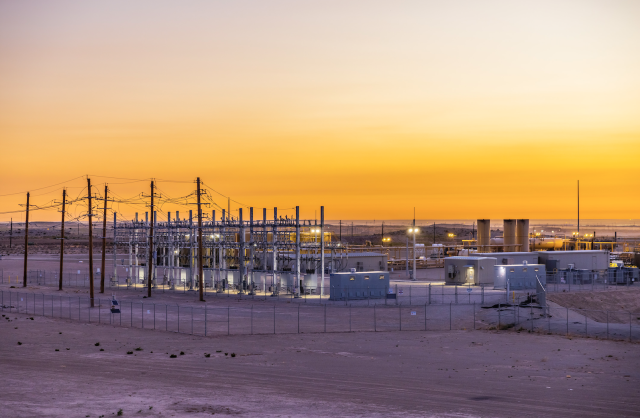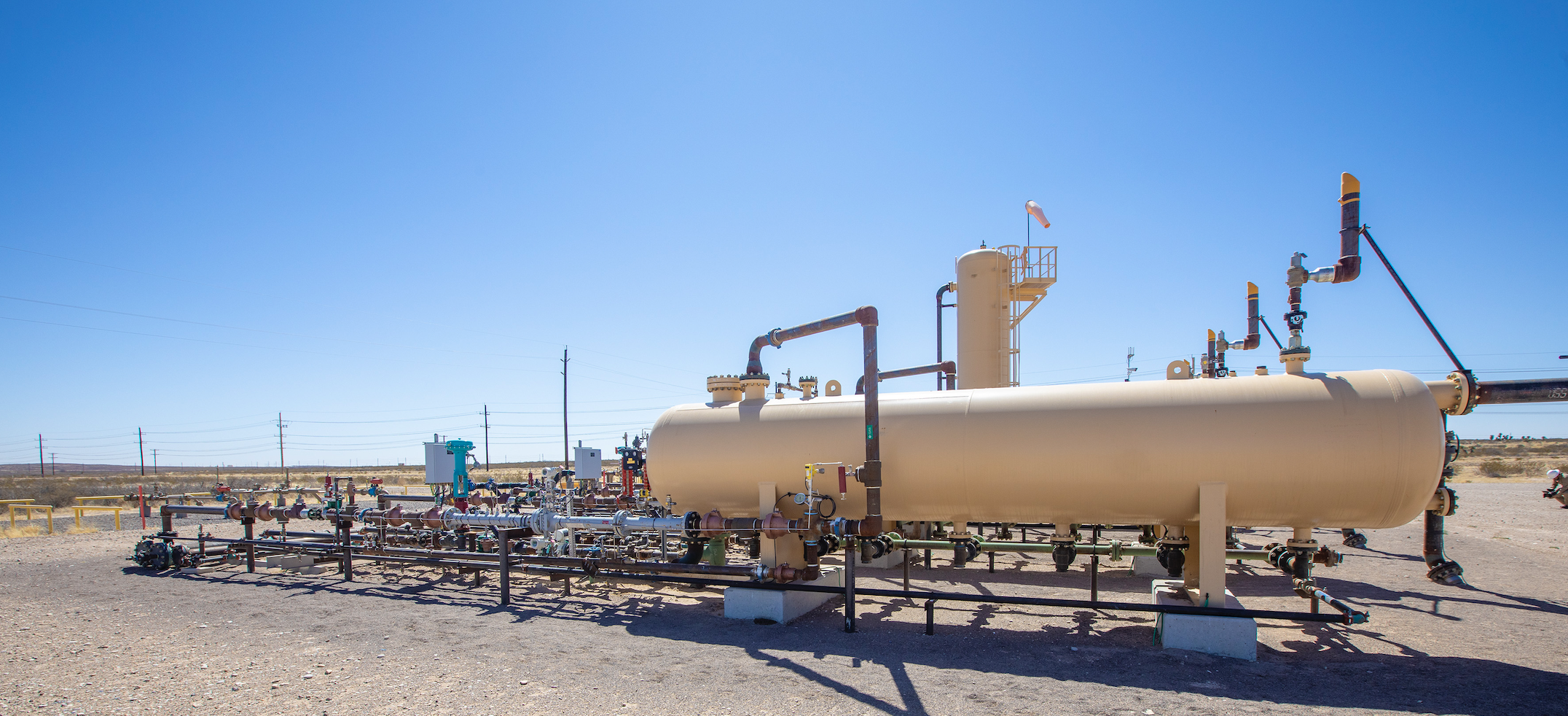
BPX Energy’s $350 million Grand Slam facility has been in operation since 2020 and processes gas from about 40% of the wells in the Permian. (Source: Marc Morrison/BPX Energy)
BPX Energy is closing in on its goal of zero routine flaring from its onshore operations as it increasingly relies on electrification and eliminates engines, flaring and other equipment prone to leaks.
BPX, which is BP’s upstream oil and gas operator in the Lower 48, initially targeted zero routine flaring by 2025 from onshore operations and pieced together several strategies to do so.
One piece of that puzzle is the company’s Grand Slam facility in Texas.
Grand Slam is an electrified central oil, gas and water handling facility that reduces operational emissions, in part by replacing gas-driven equipment, compressors and generators at individual well sites.
The company said it has made strides since 2018, when BP purchased BHP’s shale assets in the Permian for $10.5 billion. The supermajor committed to reducing emissions from acquired assets while also increasing production.

Since then, BP’s flaring intensity has decreased dramatically. As recently as fourth-quarter 2019, flaring in the Permian Basin was around 16%. Today, it’s less than 1% and dropping, Dave Lawler, CEO of BPX and BP America president and CEO, said during a conference call with journalists.
“The overall trend is significantly down,” he said, with BP’s current average for Permian operations below 1% and sometimes as low as 0.1%.
In BP’s fourth-quarter 2022 results, the operator said Permian methane flaring intensity averaged “<0.5%” in 2022, the lowest recorded in BPX Energy’s history.
“We're very close to announcing that we'll have zero routine flaring ourselves. There's very little flaring, if any, in our business at all,” Lawler said.
He attributes a lot of the progress at emissions reduction to electrification.
Cleaning up the Permian
When BPX took over the Permian assets, the acreage was largely single-well locations with typical flares, tanks, gas-driven compressors and no electricity.
There was “a lot of equipment that can be problematic in trying to manage it for methane emission and flaring,” he said. There were “a lot of emissions” from the engines, tanks, flares and equipment.
BPX spent around $800 million to update and electrify the pad sites. The new pads have no tanks, no engine compressors, no generators and no flares. All equipment on the pads run off of electric air compressors and off-grid power, making them noise-free and nearly emissions-free, he said.
“We’re on our way to about $1.4 billion in total infrastructure, but it will be an electrified infrastructure,” Lawler said.
RELATED: Permian Takeover: Multinationals in the Permian Basin
BPX has installed a 400-megawatt substation to power the field.
“Because we have this very advanced electrical distribution system that we own in our field, we can take massive loads off the high wires and then transport that electricity for, in some cases 10, 20 miles,” he said. “This is a proprietary advantage that we have because of the massive loads that we can take onto our own system.”
BPX is able to take advantage of the power infrastructure to supply power to the drilling rigs on site.
“The overhead power allows us to stimulate or frac the wells with electric frac spreads,” he said. “We pump the wells with electric submersible pumps. We compress the gas with electric driven compressors, and we operate the controls of the system with compressed natural gas from an electric source as well.”
Often, Lawler said, when companies say they are e-fracking, they are using LNG to power the generation for the electricity.
BPX is using a specialized technology to redirect power into frac trucks.
“Because we've built this massive electrical infrastructure, we're using that technology direct from the power lines straight to the pumps,” he said.
BPX is running three electric drilling rigs in the Permian in 2023, and one or two that are not electrified.
“As the development gets further along, that will enable then complete use of electric driven equipment,” he said.
By the end of 2023, 95% of BPX wells in the Permian Basin will be electrified, he said. At the time of purchase, only 4% of the wells were electrified.
BPX is also using a hub for certain processes through an electrified central oil, gas and water handling facility, which reduces the infrastructure needs at each pad.

‘Field of the future’
The operator’s $350 million Grand Slam facility has been in operation since 2020 and processes gas from about 40% of the wells in the Permian.
Grand Slam’s capacity is 35,000 barrels per day and 130 million cubic feet per day, and it can be expanded as needed.
“You don't see massive flare stacks, you don't really see anything. It’s largely an emissions-free” facility, he said, suggesting that it is “the field of the future.”
BPX plans to build three more such facilities in the Permian over the next decade. The second centralized delivery system, Bingo, is expected to go online in June or July and handle volumes similar to those at Grand Slam.
Bingo will only feature “small tweaks” to the Grand Slam design, Lawler said. Those tweaks will mostly come in the form of finetuning vessel sizing and equipment efficiency.
In addition to its efforts at minimizing emissions, BPX is also deploying methane detection technologies. The operator uses sensors, devices and alarms across the system to detect “something going wrong with the well in advance,” Lawler said.
BPX’s efforts in the Permian are part of BP’s overall goal to reduce carbon emissions. The supermajor had initially targeted a 40% reduction in emissions by 2030, but in March said it was pulling that target back to a 10% to 15% reduction by 2025 and 20% to 30% by 2030. The operator still expects to reach net zero emissions by 2050.
Recommended Reading
Will TG Natural Resources Be the Next Haynesville M&A Buyer?
2025-03-23 - TG Natural Resources, majority owned by Tokyo Gas, is looking to add Haynesville locations as inventory grows scarce, CEO Craig Jarchow said.
Voyager Midstream Closes on Panola Pipeline Interest Deal
2025-03-19 - Pearl Energy Investments portfolio company Voyager Midstream Holdings has closed on its deal with Phillips 66 for its non-op interest in the Panola Pipeline.
Sources: Citadel Buys Haynesville E&P Paloma Natural Gas for $1.2B
2025-03-13 - Hedge fund giant Citadel’s acquisition includes approximately 60 undeveloped Haynesville locations, sources told Hart Energy.
Japan’s Mitsui Testing Western Haynesville Alongside Comstock, Aethon
2025-03-26 - Japanese firm Mitsui has plans to drill a horizontal well in the emerging western Haynesville play as renewed foreign investment in U.S. shale continues to pick up steam.
NOG Spends $67MM on Midland Bolt-On, Ground Game M&A
2025-02-13 - Non-operated specialist Northern Oil & Gas (NOG) is growing in the Midland Basin with a $40 million bolt-on acquisition.
Comments
Add new comment
This conversation is moderated according to Hart Energy community rules. Please read the rules before joining the discussion. If you’re experiencing any technical problems, please contact our customer care team.






